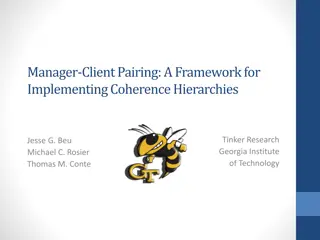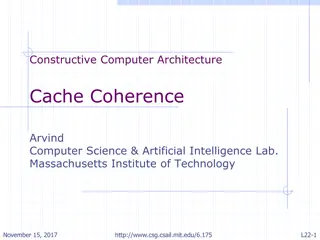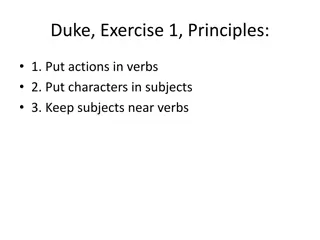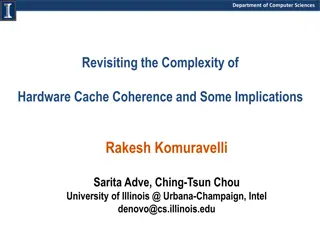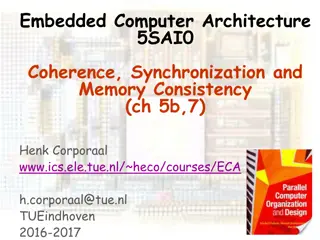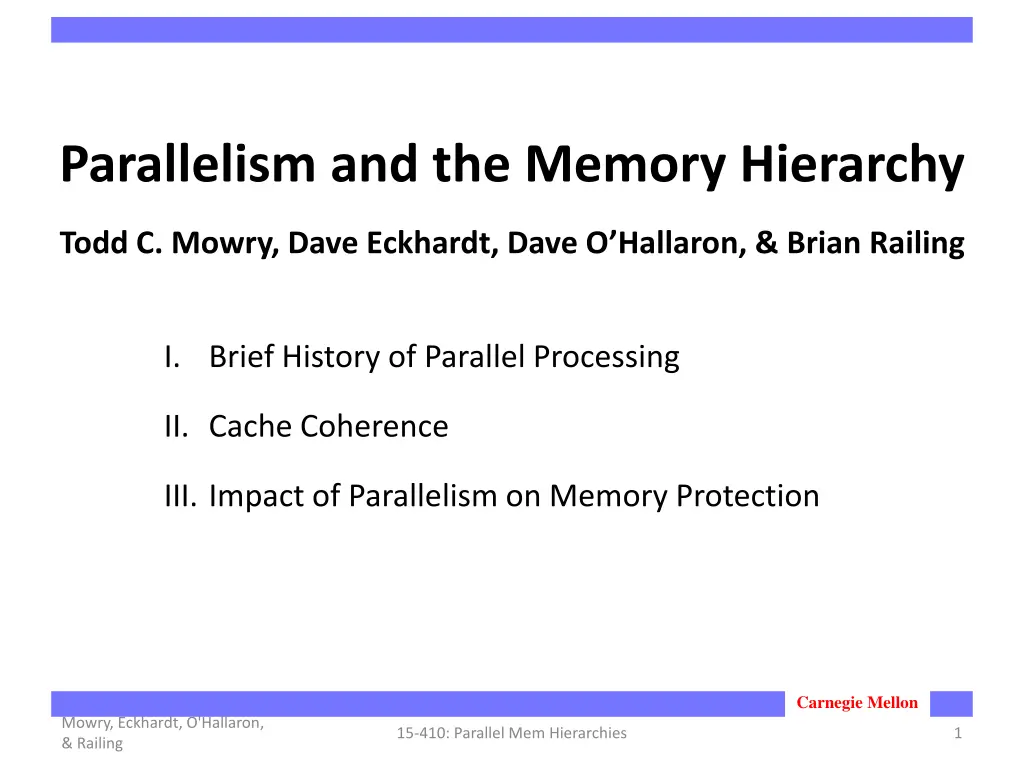
Understanding Parallelism and Memory Hierarchy: A Comprehensive Overview
Discover the evolution and impact of parallel processing in the memory hierarchy, from the history of parallelism to addressing the Power Density Wall issue. Explore the example of the Intel Core i7 processor and the implications of parallel processing on the kernel and system layers.
Download Presentation

Please find below an Image/Link to download the presentation.
The content on the website is provided AS IS for your information and personal use only. It may not be sold, licensed, or shared on other websites without obtaining consent from the author. If you encounter any issues during the download, it is possible that the publisher has removed the file from their server.
You are allowed to download the files provided on this website for personal or commercial use, subject to the condition that they are used lawfully. All files are the property of their respective owners.
The content on the website is provided AS IS for your information and personal use only. It may not be sold, licensed, or shared on other websites without obtaining consent from the author.
E N D
Presentation Transcript
Parallelism and the Memory Hierarchy Todd C. Mowry, Dave Eckhardt, Dave O Hallaron, & Brian Railing I. Brief History of Parallel Processing II. Cache Coherence III. Impact of Parallelism on Memory Protection Carnegie Mellon Mowry, Eckhardt, O'Hallaron, & Railing 15-410: Parallel Mem Hierarchies 1
A Brief History of Parallel Processing Initial Focus (starting in 1970 s): Supercomputers for Scientific Computing Another Driving Application (starting in early 90 s): Databases Inflection point in 2004: Intel hits the Power Density Wall Pat Gelsinger, ISSCC 2001 Carnegie Mellon 15-410: Parallel Mem Hierarchies 2 Mowry, Eckhardt, & O'Hallaron
Impact of the Power Density Wall The real Moore s Law continues i.e. # of transistors per chip continues to increase exponentially But thermal limitations prevent us from scaling up clock rates otherwise the chips would start to melt, given practical heat sink technology How can we deliver more performance to individual applications? increasing numbers of cores per chip Caveat: in order for a given application to run faster, it must exploit parallelism Carnegie Mellon 15-410: Parallel Mem Hierarchies 3 Mowry, Eckhardt, & O'Hallaron
Example Multicore Processor: Intel Core i7 Intel Core i7-980X (6 cores) Cores: six 3.33 GHz Nahelem processors (with 2-way Hyper-Threading ) Caches: 64KB L1 (private), 256KB L2 (private), 12MB L3 (shared) Carnegie Mellon 15-410: Parallel Mem Hierarchies 4 Mowry, Eckhardt, & O'Hallaron
Impact of Parallel Processing on the Kernel (vs. Other Layers) System Layers Kernel itself becomes a parallel program avoid bottlenecks when accessing data structures lock contention, communication, load balancing, etc. use all of the standard parallel programming tricks Thread scheduling gets more complicated parallel programmers usually assume: all threads running simultaneously load balancing, avoiding synchronization problems threads don t move between processors for optimizing communication and cache locality Primitives for naming, communicating, and coordinating need to be fast Shared Address Space: virtual memory management across threads Message Passing: low-latency send/receive primitives Programmer Programming Language Compiler User-Level Run-Time SW Kernel Hardware Carnegie Mellon 15-410: Parallel Mem Hierarchies 5 Mowry, Eckhardt, & O'Hallaron
Lets Consider Consistency Issues with the Caches CPU 0 CPU 1 CPU 2 CPU N L1 $ L1 $ L1 $ L1 $ L2 $ L2 $ L2 $ L2 $ L3 Cache Memory Carnegie Mellon 15-410: Parallel Mem Hierarchies 6 Mowry, Eckhardt, & O'Hallaron
Caches in a Single-Processor Machine (Review from 213) Ideally, memory would be arbitrarily fast, large, and cheap unfortunately, you can t have all three (e.g., fast small, large slow) cache hierarchies are a hybrid approach if all goes well, they will behave as though they are both fast and large Cache hierarchies work due to locality temporal locality even relatively small caches may have high hit rates spatial locality move data in blocks (e.g., 64 bytes) Locating the data: Main memory: directly (geographically) addressed we know exactly where to look: at the unique location corresponding to the address Cache: may or may not be somewhere in the cache need tags to identify the data may need to check multiple locations, depending on the degree of associativity Carnegie Mellon 15-410: Parallel Mem Hierarchies 7 Mowry, Eckhardt, & O'Hallaron
Locate set Check if any line in set has matching tag Yes + line valid: hit Locate data starting at offset Cache Read E = 2e lines per set Address of word: t bits s bits b bits S = 2s sets set index block offset tag data begins at this offset tag B-1 v 0 1 2 valid bit B = 2b bytes per cache block (the data) Carnegie Mellon 15-410: Parallel Mem Hierarchies 8 Mowry, Eckhardt, & O'Hallaron
Intel Quad Core i7 Cache Hierarchy Processor package Core 0 Core 3 L1 I-cache and D-cache: 32 KB, 8-way, Access: 4 cycles Regs Regs L1 L1 L1 L1 D-cache I-cache D-cache I-cache L2 unified cache: 256 KB, 8-way, Access: 11 cycles L2 unified cache L2 unified cache L3 unified cache: 8 MB, 16-way, Access: 30-40 cycles L3 unified cache (shared by all cores) Block size: 64 bytes for all caches. Main memory Carnegie Mellon 15-410: Parallel Mem Hierarchies 9 Mowry, Eckhardt, & O'Hallaron
Simple Multicore Example: Core 0 Loads X load r1 X (r1 = 17) Core 0 Core 3 L1-D L1-D (1) Miss X 17 L2 L2 (2) Miss X 17 L3 X 17 (3) Miss Main memory (4) Retrieve from memory, fill caches X: 17 Carnegie Mellon 15-410: Parallel Mem Hierarchies 10 Mowry, Eckhardt, & O'Hallaron
Example Continued: Core 3 Also Does a Load of X load r2 X (r2 = 17) Core 0 Example of constructive sharing: Core 3 benefited from Core 0 bringing X into the L3 cache Core 3 L1-D L1-D (1) Miss X 17 X 17 L2 L2 X 17 X 17 (2) Miss Fairly straightforward with only loads. But what happens when stores occur? L3 (3) Hit! (fill L2 & L1) X 17 Main memory X: 17 Carnegie Mellon 15-410: Parallel Mem Hierarchies 11 Mowry, Eckhardt, & O'Hallaron
Review: How Are Stores Handled in Uniprocessor Caches? store 5 X L1-D 17 17 5 X L2 X 17 What happens here? L3 We need to make sure we don t have a consistency problem X 17 Main memory X: 17 Carnegie Mellon 15-410: Parallel Mem Hierarchies 12 Mowry, Eckhardt, & O'Hallaron
Options for Handling Stores in Uniprocessor Caches Option 1: Write-Through Caches propagate immediately store 5 X L1-D What are the advantages and disadvantages of this approach? 17 17 5 X (1) L2 17 17 5 X (2) L3 17 17 5 X (3) Main memory 17 5 X: 17 Carnegie Mellon 15-410: Parallel Mem Hierarchies 13 Mowry, Eckhardt, & O'Hallaron
Options for Handling Stores in Uniprocessor Caches Option 2: Write-Back Caches defer propagation until eviction keep track of dirty status in tags Option 1: Write-Through Caches propagate immediately store 5 X (Analogous to PTE dirty bit.) L1-D L1-D 17 17 5 17 17 5 X X Dirty Upon eviction, if data is dirty, write it back. L2 L2 17 17 5 X 17 X Write-back is more commonly used in practice (due to bandwidth limitations) L3 L3 17 17 5 X 17 X Main memory Main memory 17 5 X: 17 X: 17 Carnegie Mellon 15-410: Parallel Mem Hierarchies 14 Mowry, Eckhardt, & O'Hallaron
Resuming Multicore Example 1. xadd -12, X (store 5 X) 2. load r2 X (r2 = 17) Hmm Core 0 Core 3 What is supposed to happen in this case? L1-D L1-D Hit! 17 17 5 Dirty X X 17 Is it incorrect behavior for r2 to equal 17? if not, when would it be? L2 L2 X 17 X 17 L3 (Note: core-to-core communication often takes tens of cycles.) X 17 Main memory X: 17 Carnegie Mellon 15-410: Parallel Mem Hierarchies 15 Mowry, Eckhardt, & O'Hallaron
What is Correct Behavior for a Parallel Memory Hierarchy? Note: side-effects of writes are only observable when reads occur so we will focus on the values returned by reads Intuitive answer: reading a location should return the latest value written (by any thread) Hmm what does latest mean exactly? within a thread, it can be defined by program order but what about across threads? the most recent write in physical time? hopefully not, because there is no way that the hardware can pull that off e.g., if it takes >10 cycles to communicate between processors, there is no way that processor 0 can know what processor 1 did 2 clock ticks ago most recent based upon something else? Hmm Carnegie Mellon 15-410: Parallel Mem Hierarchies 16 Mowry, Eckhardt, & O'Hallaron
Refining Our Intuition Thread 0 Thread 1 Thread 2 // write evens to X for (i=0; i<N; i+=2) { X = i; } // write odds to X for (j=1; j<N; j+=2) { X = j; } A = X; B = X; C = X; (Assume: X=0 initially, and these are the only writes to X.) What would be some clearly illegal combinations of (A,B,C)? How about: (4,8,1)? (9,12,3)? (7,19,31)? What can we generalize from this? writes from any particular thread must be consistent with program order in this example, observed even numbers must be increasing (ditto for odds) across threads: writes must be consistent with a valid interleaving of threads not physical time! (programmer cannot rely upon that) Carnegie Mellon 15-410: Parallel Mem Hierarchies 17 Mowry, Eckhardt, & O'Hallaron
Visualizing Our Intuition Thread 0 Thread 1 Thread 2 // write evens to X for (i=0; i<N; i+=2) { X = i; } // write odds to X for (j=1; j<N; j+=2) { X = j; } A = X; B = X; C = X; CPU 2 CPU 0 CPU 1 Single port to memory Memory Each thread proceeds in program order Memory accesses interleaved (one at a time) to a single-ported memory rate of progress of each thread is unpredictable Carnegie Mellon 15-410: Parallel Mem Hierarchies 18 Mowry, Eckhardt, & O'Hallaron
Correctness Revisited Thread 0 Thread 1 Thread 2 // write evens to X for (i=0; i<N; i+=2) { X = i; } // write odds to X for (j=1; j<N; j+=2) { X = j; } A = X; B = X; C = X; CPU 2 CPU 0 CPU 1 Single port to memory Memory Recall: reading a location should return the latest value written (by any thread) latest means consistent with some interleaving that matches this model this is a hypothetical interleaving; the machine didn t necessary do this! Carnegie Mellon 15-410: Parallel Mem Hierarchies 19 Mowry, Eckhardt, & O'Hallaron
Lecture Checkpoint 1 Check your understanding 1) What are the two ways writes are handled in caches? 2) What is program order? How does it help with reasoning on legal thread interleavings? Carnegie Mellon Mowry, Eckhardt, O'Hallaron, 15-410: Parallel Mem Hierarchies 20 & Railing
Two Parts to Memory Hierarchy Correctness 1. Cache Coherence do all loads and stores to a given cache block behave correctly? i.e., are they consistent with our interleaving intuition? important: separate cache blocks have independent, unrelated interleavings! 2. Memory Consistency Model do all loads and stores, even to separate cache blocks, behave correctly? builds on top of cache coherence especially important for synchronization, causality assumptions, etc. Carnegie Mellon 15-410: Parallel Mem Hierarchies 21 Mowry, Eckhardt, & O'Hallaron
Cache Coherence: Beyond the One Cache How do we implement L1 & L2 cache coherence between the cores? store 5 X Core 0 Core 3 L1-D L1-D X 17 X 17 ??? L2 L2 X 17 X 17 L3 X 17 Common approaches: update or invalidate protocols Carnegie Mellon 15-410: Parallel Mem Hierarchies 22 Mowry, Eckhardt, & O'Hallaron
One Approach: Invalidate Protocol Basic idea: to perform a write, first delete any shared copies in peer caches store 5 X Core 0 Core 3 L1-D L1-D 17 17 5 X X X 17 17 Invalid Delete X invalidate L2 L2 17 17 5 X X X 17 17 Invalid L3 17 17 5 X Carnegie Mellon 15-410: Parallel Mem Hierarchies 23 Mowry, Eckhardt, & O'Hallaron
How Invalidation-Based Cache Coherence Works (Short Version) Cache lines contain additional coherence state ( MESI example below): Invalid: nothing here (often as the result of receiving an invalidation message) Shared (Clean): matches the value in memory; other processors may have shared copies also I can read this, but cannot write it until I get an exclusive/modified copy Modified (aka Dirty): has been modified, and does not match memory; I have the only copy I can read or write this; I must supply the block if another processor wants to read Exclusive (Clean): matches the value in memory; I have the only copy I can read or write this (a write causes a transition to the Modified state) (Not Messi ) The hardware keeps track of this automatically using either broadcast (if interconnect is a bus) or a directory of sharers Carnegie Mellon 15-410: Parallel Mem Hierarchies 24 Mowry, Eckhardt, & O'Hallaron
Review: Invalidation Communication In performing a write, first delete any shared copies in peer caches store 5 X Core 0 Core 3 L1-D L1-D 17 17 5 X X X 17 17 Invalid Delete X invalidate L2 L2 17 17 5 X X X 17 17 Invalid L3 17 17 5 X Carnegie Mellon 15-410: Parallel Mem Hierarchies 26 Mowry, Eckhardt, & O'Hallaron
How is Coherence Recorded? In our uniprocessor cache, we have many sets Each set has many lines Each line tracks the state for a block of memory Each line is: Valid? Dirty? In a multiprocessor cache, each line is: M or E or S or I What are the hits / misses on a shared line? Carnegie Mellon Mowry, Eckhardt, O'Hallaron, 15-410: Parallel Mem Hierarchies 27 & Railing
Performance Impact of Invalidation-Based Cache Coherence Invalidations result in a new source of cache misses! Recall that uniprocessor cache misses can be categorized as: (i) cold/compulsory misses, (ii) capacity misses, (iii) conflict misses Due to the sharing of data, parallel machines also have communication misses: (iv) true sharing misses e.g., Core A reads X Core B writes X Core A reads X again (cache miss) nothing surprising here; this is true communication (v) false sharing misses e.g., Core A reads X Core B writes Y Core A reads X again (cache miss) What??? where X and Y unfortunately fell within the same cache block Carnegie Mellon 15-410: Parallel Mem Hierarchies 28 Mowry, Eckhardt, & O'Hallaron
Lecture checkpoint 2 Check your understanding 1) What are the four Cs of cache misses? 2) Which state does a cache line need to be in before the value can be changed? 3) What are the four states of MESI? Carnegie Mellon Mowry, Eckhardt, O'Hallaron, 15-410: Parallel Mem Hierarchies 29 & Railing
Beware of False Sharing! Thread 0 Thread 1 while (TRUE) { X += } while (TRUE) { Y += } X Y 1 block invalidations, cache misses Core 0 Core 1 L1-D L1-D X Y X Y It can result in a devastating ping-pong effect with a very high miss rate plus wasted communication bandwidth Pay attention to data layout: the threads above appear to be working independently, but they are not Carnegie Mellon 15-410: Parallel Mem Hierarchies 30 Mowry, Eckhardt, & O'Hallaron
How False Sharing Might Occur in the OS Operating systems contain lots of counters (to count various types of events) many of these counters are frequently updated, but infrequently read Simplest implementation: a centralized counter // Number of calls to get_tid intgettid_ctr = 0; int gettid(void) { atomic_add(&gettid_ctr,1); return (running->tid); } int get_gettid_events(void) { return (gettid_ctr); } Perfectly reasonable on a sequential machine. But it performs very poorly on a parallel machine. Why? each update of get_tid_ctrinvalidates it from other processor s caches Carnegie Mellon 15-410: Parallel Mem Hierarchies 31 Mowry, Eckhardt, & O'Hallaron
Improved Implementation: An Array of Counters Each processor updates its own counter To read the overall count, sum up the counter array intgettid_ctr[NUM_CPUs]= {0}; int gettid(void) { // exact coherence not required gettid_ctr[running->CPU]++; return (running->tid); } No longer need a lock around this. int get_gettid_events(void) { int cpu, total = 0; for (cpu = 0; CPU < NUM_CPUs; cpu++) total += gettid_ctr[cpu]; return (total); } Eliminates lock contention, but may still perform very poorly. Why? False sharing! Carnegie Mellon 15-410: Parallel Mem Hierarchies 32 Mowry, Eckhardt, & O'Hallaron
Faster Implementation: Padded Array of Counters Put each private counter in its own cache block. (any downsides to this?) Even better: replace PADDING with other useful per-CPU counters. struct { intget_tid_ctr; int PADDING[INTS_PER_CACHE_BLOCK-1]; } ctr_array[NUM_CPUs]; int get_tid(void) { ctr_array[running->CPU].get_tid_ctr++; return (running->tid); } int get_tid_count(void) { int cpu, total = 0; for (cpu = 0; CPU < NUM_CPUs; cpu++) total += ctr_array[cpu].get_tid_ctr; return (total); } Carnegie Mellon 15-410: Parallel Mem Hierarchies 33 Mowry, Eckhardt, & O'Hallaron
Parallel Counter Implementation Summary Centralized: Simple Array: CPU 3 CPU 3 CPU 0 CPU 1 CPU 2 CPU 0 CPU 1 CPU 2 Mutex contention? False sharing? Cache Block Padded Array: Clustered Array: CPU 3 CPU 3 CPU 0 CPU 1 CPU 2 CPU 0 CPU 1 CPU 2 Cache Block Cache Block Cache Block Cache Block Cache Block Cache Block Wasted space? (If there are multiple counters to pack together.) Carnegie Mellon 15-410: Parallel Mem Hierarchies 34 Mowry, Eckhardt, & O'Hallaron
True Sharing Can Benefit from Spatial Locality Thread 0 Thread 1 X = Y = X Y r1 = X; r2 = Y; 1 block Cache Miss Cache Hit! Core 0 Core 1 both X and Y sent in 1 miss L1-D L1-D X Y X Y With true sharing, spatial locality can result in a prefetching benefit Hence data layout can help or harm sharing-related misses in parallel software Carnegie Mellon 15-410: Parallel Mem Hierarchies 35 Mowry, Eckhardt, & O'Hallaron
Case Study: Protection Shared Address Space: access permissions for virtual memory pages e.g., set pages to read-only during copy-on-write optimization Carnegie Mellon 15-410: Parallel Mem Hierarchies 36 Mowry, Eckhardt, & O'Hallaron
Lets Revisit Consistency Issues with the Caches TLB 0 TLB 1 TLB 2 TLB N CPU 0 CPU 1 CPU 2 CPU N L1 $ L1 $ L1 $ L1 $ L2 $ L2 $ L2 $ L2 $ L3 Cache Memory Carnegie Mellon 15-410: Parallel Mem Hierarchies 37 Mowry, Eckhardt, & O'Hallaron
How Do We Propagate Changes to Access Permissions? What if parallel machines (and VM management) simply looked like this: (assume that this is a parallel program, deliberately sharing pages) CPU 0 CPU 1 CPU 2 CPU N (No caches or TLBs.) Set Read-Only Memory Page Table Read-Write Read-Only f029 Read-Only f835 Updates to the page tables (in shared memory) could be read by other threads But this would be a very slow machine! Why? Carnegie Mellon 15-410: Parallel Mem Hierarchies 38 Mowry, Eckhardt, & O'Hallaron
VM Management in a Multicore Processor TLB 0 TLB 1 TLB 2 TLB N CPU 0 CPU 1 CPU 2 CPU N L1 $ L1 $ L1 $ L1 $ L2 $ L2 $ L2 $ L2 $ Set Read-Only L3 Cache Memory Page Table Read-Write Read-Only f029 Read-Only f835 TLB Shootdown : relevant entries in the TLBs of other processor cores need to be flushed Carnegie Mellon 15-410: Parallel Mem Hierarchies 39 Mowry, Eckhardt, & O'Hallaron
TLB Shootdown (Example Design) TLB 0 TLB 1 TLB 2 TLB N CPU 0 CPU 1 CPU 2 CPU N Lock PTE Page Table Read-Write Read-Only 0 1 2 N f029 Read-Only f835 1. Initiating core triggers OS to lock the corresponding Page Table Entry (PTE) 2. OS generates a list of cores that may be using this PTE (erring conservatively) 3. Initiating core sends an Inter-Processor Interrupt (IPI) to those other cores requesting that they invalidate their corresponding TLB entries 4. Initiating core invalidates local TLB entry; waits for acknowledgements 5. Other cores receive interrupts, execute interrupt handler which invalidates TLBs send an acknowledgement back to the initiating core 6. Once initiating core receives all acknowledgements, it unlocks the PTE Carnegie Mellon 15-410: Parallel Mem Hierarchies 40 Mowry, Eckhardt, & O'Hallaron
TLB Shootdown Timeline Image from: Villavieja et al, DiDi: Mitigating the Performance Impact of TLB Shootdowns Using a Shared TLB Directory. In Proceedings of PACT 2011. Carnegie Mellon 15-410: Parallel Mem Hierarchies 41 Mowry, Eckhardt, & O'Hallaron
Summary Part 1 of Memory Correctness: Cache Coherence reading latest value does not correspond to physical time! corresponds to latest in hypothetical interleaving of accesses new sources of cache misses due to invalidations: true sharing misses false sharing misses Case study: memory protection on a parallel machine TLB shootdown involves Inter-Processor Interrupts to flush TLBs Looking ahead: Part 2 of Memory Correctness, plus Scheduling Revisited Carnegie Mellon 15-410: Parallel Mem Hierarchies 42 Mowry, Eckhardt, & O'Hallaron
Update vs. Invalidate When is one approach better than the other? (hint: the answer depends upon program behavior) Key question: Is a block written by one processor read by others before it is rewritten? if so, then update may win: readers that already had copies will not suffer cache misses if not, then invalidate wins: avoids useless updates (including to dead copies) Which one is used in practice? invalidate (due to hardware complexities of update) although some machines have supported both (configurable per-page by the OS) Carnegie Mellon 15-410: Parallel Mem Hierarchies 43 Mowry, Eckhardt, & O'Hallaron
One Approach: Update Protocol Basic idea: upon a write, propagate new value to shared copies in peer caches store 5 X Core 0 Core 3 L1-D L1-D 17 17 5 17 17 5 X X X = 5 update L2 L2 17 17 5 17 17 5 X X L3 17 17 5 X Carnegie Mellon 15-410: Parallel Mem Hierarchies 44 Mowry, Eckhardt, & O'Hallaron
















